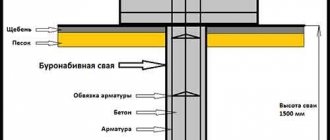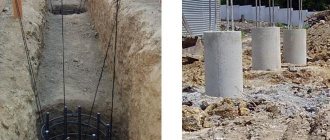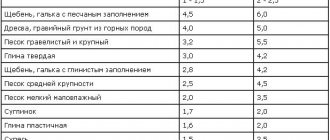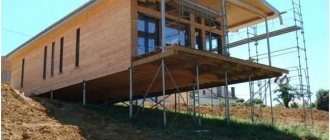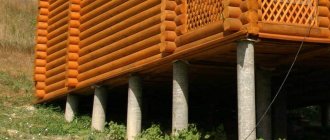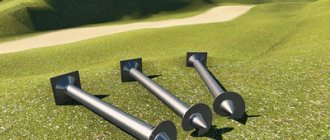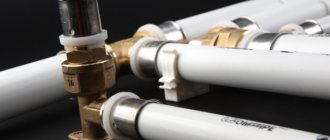We install bored piles with casing in Moscow and the Moscow region
Buy Larsen sheet piling Technology for installing bored piles Installation of bored piles in water-saturated soils Turnkey bored foundation
The Arctic Hydro Stroy enterprise installs bored foundations for all types of structures in Moscow and the Moscow region.
In conditions of complex loose soils, where the walls of the well are easily destroyed, we use the technology of bored piles with casing.
The essence of technology
Casing pipes for bored piles (BPS), used in foundation construction, can differ in both their geometric parameters and design. The high reliability of foundation structures obtained using this technology is ensured by the fact that their basis, in addition to concrete, consists of frames for the manufacture of which metal reinforcement is used. The structure obtained using this method is not only securely fixed in the ground, but also itself demonstrates exceptionally high rigidity and stability.
Technological process for installing bored piles with casing
The technology for constructing bored piles is as follows:
- A well of the required diameter and depth approved by the project is drilled in a pre-selected location on the construction site, for which a special drilling rig is used.
- A casing pipe for piles is immersed into the resulting well. It is important that the depth to which such pipes are immersed is pre-calculated and approved by the project.
- The internal cavity of the pipe is freed from crumbled earth. To do this, various technical means are used (in particular, soil can be washed out of the pipe using water supplied under significant pressure).
- A reinforcement cage for a bored pile is lowered into the hole in the casing, cleared of crumbled earth.
- Concrete solution is poured into the internal cavity of the pipe, in which the reinforcement cage is placed. This process, in professional terms, is precisely called pile driving.
- After pouring the concrete, the casing pipes are removed from the ground section by section.
Naturally, the installation of bored piles is carried out using a technology that has a number of nuances. They must be taken into account during its practical implementation.
What is a casing pipe for bored piles
Bored piles are reinforced concrete rods that are not delivered to the site in finished form, but are formed right on the spot: wells are drilled, a finished frame is placed in them, and concrete is poured. On dense soil, strengthening the walls of the wells is not required. When they are moderately loose, they are strengthened using a bentonite (clay) solution, which is used for washing.
On very loose soil, the best option is to install bored piles using casing pipes: simultaneously with drilling, the casing pipe is lowered into the well.
After drilling, reinforcement and pouring of concrete, the pipe is sometimes left in the ground: it continues to serve as a frame for the pile and performs the function of waterproofing. But wherever possible, they extract it: the turnover of casing pipes is one of the ways to reduce the cost of the foundation construction process.
The sequence of installation of bored piles with casing pipe and grillage:
- Geological surveys at the work site, selection of optimal technology.
- Calculation and design of piles.
- Site marking.
- Equipment adjustment.
- Drilling a well with simultaneous immersion of the casing. At great depths, the pipe is extended to form a column.
- Removing soil from the face (for example, washing).
- Reinforcement.
- Pouring concrete.
- Sectional removal of casing.
- Formation of the pile head.
- After installing all the piles, install the formwork, reinforcement and pour the grillage.
We have been installing bored piles for over 10 years
For any questions call: 8 800 707-72-09
We will help you choose the most suitable and economical option for manufacturing a bored foundation.
Installation of casing bored piles
Installation and installation of a pile foundation is carried out directly on the construction site. In principle, the technology for installing such a structure with your own hands is quite simple: you need to lower a pipe into the well, carry out reinforcement and concrete it. In length, such structures can be up to thirty meters with a diameter of up to one and a half meters, although with improved technical support, the length can be doubled and the cross-section increased to 3.5 m. With such parameters, the bearing capacity of bored supports will be 500 tons.
In most cases, the structure is buried 5 - 12 m with a diameter of 25 - 40 cm. Do-it-yourself assembly of metal structures is carried out according to the following scheme:
- The well is filled with concrete mortar per meter;
- the solution is compacted;
- the casing is gradually raised to the level when the concrete drops by 35 - 40 cm;
- this process must be repeated until the rod is completely filled with the mortar mass.
Pile design
The walls of the leader hole for the casing pipe during drilling become rough and loose due to collapsed soil, so a gap is formed between the hole and the metal structure, which is compacted with a solution, and the concrete, in turn, seeps into the soil structure and makes it stronger . This technology has one drawback, and it is that you cannot control the density of the concrete pour inside a long shaft. This minus can lead to erosion by groundwater of areas of the mixture that have not set, if there are any, of course.
The well for the pipe foundation is reinforced only in the upper part, while the reinforcement cage is buried 1.5 - 2 m into fresh concrete. Along with the casing pipe, the dry method is also used, suitable for stable and dense soils that can withstand the load without destroying the walls. The frame is installed in the well with your own hands, and then the mortar mass is filled. If bored wells are sunk into weak, watery soils without casing, then their walls must be reinforced with clay coating, the density of which must be at least 1.2 g/m3.
Advantages of installing bored piles in casing pipe
Casing pipes themselves are a technological solution for a certain type of soil. Its advantages include the turnover of casing pipes when installing bored piles: depending on the nature of the soil and the type of casing pipe itself, the turnover can vary from 5 to 300 cycles.
In addition to drilling construction, they can also be used to strengthen water and oil and gas wells.
The advantages of bored piles themselves are as follows:
- The large load-bearing capacity allows the construction of both light log houses and urban multi-storey buildings on such foundations. Everything is determined by the parameters of the piles;
- versatility - any soil except rocky and coarse soils is suitable for installation;
- suitable for constructing foundations on slopes;
- possibility of installation in urban conditions - the absence of noise and vibration allows you to work without risk to surrounding structures and discomfort for people;
- the price of bored piles with casing is relatively low: installation requires less material than slab and buried strip foundations; heavy, expensive equipment for driving finished piles is not needed;
- all stages of pile installation are available for control;
- can be used not only for constructing new foundations, but also for strengthening old foundations of various types.
The advantage of technology using bored piles
Casing pipe is a reliable way to strengthen the soil wall in the holes being formed. Pipes for bored piles consist of rigidly connected sections. The use of this technology in practice is effective not only on problematic soils, but also when developing buildings in metropolitan areas on a small area. The speed of processing and the cost of installation depends on the main factors:
- general condition of drilling equipment;
- diameter and depth of the well;
- soil type.
The principle of the technology for installing bored piles with casing is quite simple. When forming deep rods, a drill shaft is formed step by step with pipes interlocking one after another. It is important to tightly fix the casing (from any material) as you move deeper.
- Drilling equipment is installed at the prepared site, which makes wells of the designed width and depth.
- Plastic or metal casing pipes for bored piles are buried using a screw-in shaft pipe. The required level is fixed in advance in the design documentation.
- Fragments of pipes are interconnected in the same way as is provided for products made of one or another material, the so-called “advanced penetration”.
- When the drill column is fully formed, the soil that crumbled during the formation of the hole is removed.
- A frame made of reinforcement under the piles is inserted into the prepared shaft.
- The prepared cement-sand mixture is supplied in portions through a concrete pipe (piling).
- The casing is removed from the well section by section.
Cement-sand mixture is poured into the prepared well in small portions
Advantages of safe technology for inserting bored piles with casing:
- the ability to work near nearby structures, due to the absence of shock and vibration processes during excavation;
- work in difficult soils (floating, water-saturated, weak and crumbling, saline);
- guarantee of perfect vertical alignment and 100% drilling quality;
- high productivity of drilling equipment,
- possibility of deep work with overlapping horizons;
- safety of piling work;
- 100% protection of well shafts from collapse and control of all stages of the process;
- protection of the drilling shaft from groundwater;
- saving concrete with efficient pouring (without necks);
- minimizing the number of miscalculations during installation;
- drilling, widening, extraction of boulders and large fractions when working with a drill;
- control of compliance of design parameters with practical work;
- the maximum possible load-bearing functionality of the well due to a high-quality wall.
One of the types of casing pipes are plastic products. Polymer parts are produced for different purposes from the following types of materials:
- LDPE – high-density polyethylene;
- HDPE – low-density polyethylene;
- PNP – low density polyethylene;
- PVC – polyvinyl chloride.
The wall thickness of the casing pipes varies within 40mm. These products have many advantages:
- sufficient tightness of the connection;
- absence of corrosion processes;
- low cost relative to metal products;
- light weight;
- high resistance to chemical or other aggressive environments;
- accelerated installation due to simple connection of casing cylinder sections.
Polymer casing pipes can only be used for constructing domestic water wells
The only negative is that plastic casing pipes are not very strong, which is why it is easy to destroy their integrity with a sharp blow with a sharp tool and they are not suitable as casing with BNS. These products are preferred to be used because of their low cost and practicality for drilling domestic wells for water supply to private households.
Completed objects
see all
Installation of sheet piling fencing at wastewater treatment plants of apartment buildings
In 2021, our company installed sheet piling fences at the wastewater treatment plant of a residential multi-apartment building in the village of Rasskazovka
26.06.2016
see all
North-Eastern section of the third interchange circuit
A set of works for the installation of sheet piling to a depth of 14.5 m
5.05.2016
see all
Design and installation of sheet pile fencing made of pipe and pile piles during the construction of a shopping complex.
Our company took part in the construction of an administrative and shopping complex with a parking lot in the city of Zhukovsky, Moscow region.
02.06.2016
see all
Sheet piling fencing of a pit during the construction of a multi-storey residential building
Our specialists carried out comprehensive work on the installation of sheet piling fencing for a pit during the construction of a multi-storey residential building with an underground parking lot and built-in public premises
6.07.2016
see all
Supply, installation and removal of sheet piles during the reconstruction of a sewage pumping station
Our company installed sheet piling during the reconstruction of a sewage pumping station in Shcherbinka (Moscow region).
26.06.2016
see all
Installation of sheet piling from Larsen sheet pile using vibration immersion method
Installation of sheet piling from Larsen sheet piling using the vibration immersion method at the construction site of an administrative building in Moscow, on the street. Baikalskaya, 42.
14.07.2017
CASING PIPE FOR DRILLED PILES
D 426mm 620mm 750mm 880mm 1000mm 1180mm 1200mm 1300mm 150mm0 1800mm 2000mm 2200mm 2500mm
PIPE CLAMPS. DREITELLERS. KNIFE SECTIONS. CONCRETE PIPES VPT and OTHERS
————————————-
Rice. Shipment of casing inventory pipes 880mm for export.
click on photo to enlarge
———————————
SUB-SECTIONS:
- SMALL DIAMETER CASING PIPES D<620mm
- PIPE CLAMPS
- CONCRETE PIPES
- DREITELLERS
- CENTERING RINGS
- KNIFE SECTIONS
- SMALL DIAMETER CASING PIPES
- VPT CASSETTE FOR CONCRETE PIPE
————————————————
Casing inventory pipes, related drilling tools and equipment are designed for the installation of bored piles in loose, water-saturated, unstable and other complex soils.
Casing inventory pipes are a high-precision drilling tool. Due to the tightness of the connection, casing pipes allow work to be carried out even in heavily waterlogged soils. The slightest errors in design or technology/production can lead to catastrophic consequences (loss of casing, tool jamming, watering of the casing string or simply impossibility of drilling, etc.)
Video. Casing pipe before welding. Manufactured by TRIS
The main mistakes in the production of casing pipes:
- Failure to comply with the accuracy of flange boring, which leads to a lack of interchangeability of pipes (some pipes do not fit together)
- The ellipse (ovoid shape) of the pipe body that occurs during the rolling process and after improper installation and subsequent welding - this leads to the impossibility of passing the tool or rapid abrasion of the inner wall and failure of the pipe.
- The use of cheap steel (waste or obviously low-quality steel) in the production - this leads to ruptures in the metal, instant wear of the main seats and riveting of the flange ends.
For many years, our company has specialized in the production of casing pipes and other drilling tools intended for the installation of bored piles. When producing our products, we pay special attention to quality and strictly adhere to production technology, which allows us to produce drilling tools at the level of the world's leading manufacturers. Therefore, the above errors in the production of casing pipes at our enterprise are excluded.
Rice. Flanges after control joining. Preparation for assembly of casing pipes.
click on photo to enlarge
Distinctive features of TRIS products:
- Guarantee of the use of high-quality wear-resistant steels on flange connections of casing inventory pipes. This allows you to increase the service life of pipes and reduce the cost of purchasing new drilling tools.
- High precision machining of flanges. This ensures the interchangeability and ease of assembly/disassembly of pipes at the drilling site. Therefore, the use of TRIS pipes allows you to accurately calculate the working time spent on installation/dismantling of the casing and increase productivity due to the absence of downtime (due to repairs, adjustments, etc.).
- High-precision assembly, joining and subsequent welding work without thermal straightening and “adjustment” . The accuracy of the geometry ensures the absence of runout during rotation, thereby protecting the power units of the drilling machine from vibration destruction.
- Guarantee of the use of high-quality consumables (plugs, threaded and conical bushings) designed for long-term dynamic loads. This allows the pipes to operate without restrictions on the “make-up/unscrew” cycles in the “plug-bushing” assembly, and also allows them to withstand any loads during the drilling process.
- The use of ESAB welding materials produced in Europe with the mechanical properties of the welding wire exceeding the properties of the steel being welded. This ensures the highest level of quality of welded joints and the necessary margin of safety for the entire structure.
- Knife sections with modern welded and replaceable cutters made of high-strength thick sheet steel. This ensures reliable drilling of the casing. Modern, highly efficient cutters ensure that the integrity of the cutting part is maintained.
Rice. Some stages of manufacturing casing pipes and finished casing pipes from TRIS
click on photo to enlarge
Our company specializes in the production of non-standard drill casing pipes with a reduced diameter (less than 620 mm), increased diameter (2500 mm or more), as well as with a modified design of walls and flanges. Please send your requests to our email; maximum response time is 1 day.
————-
Contact Information:
Tel: +
Email:
The rest of the information is in the “Contacts”
——————————-
Types of inventory casing pipes for bored piles
Casing pipes for bored piles differ in design, material of manufacture and geometric parameters - the height of the column is equal to the depth of the pile, the diametrical cross-section of the pipe is equal to the cross-section of the pile.
According to the material there are:
- made of high-alloy or black steel;
- polypropylene;
- made of low-density polyethylene;
- from unplasticized PVC;
- asbestos-cement.
For bored piles, steel, single-walled and double-walled are most often used. In the second type, the inner wall is smooth, and the outer wall is reinforced with spiral ribs.
Since the scope of application of bored piles is practically unlimited, the range of casing pipes is also very large. The thickness of the pipe wall is related to the diameter. For example, casing pipes for bored piles with a diameter of 620 have a wall thickness of 4 cm.
Casing pipe diameters for bored piles and steel thickness:
- from 60 cm (external diameter) to 52 (internal) to 148/140 - 4 cm;
- 180/170 and 190/180 – 5;
- from 200/188 to 250/238 – 6.
Advantages of bored piles
- high load-bearing capacity on the ground and on the support material
- immersion of piles to a depth of up to 45 meters and in some cases even deeper, which is not possible with the pile driver method of immersion
- in the manufacture of BNS there are no powerful dynamic impacts through the soil on the foundations of neighboring buildings (as during driving), therefore this method is widely used in Moscow and other cities with dense buildings
- when installing a BPS, the strength properties of clay soils are preserved
- provide the installation of a pile foundation in water-saturated, quicksand soils, with a high level of groundwater filtration (when using casing pipes).
A group of drilling rigs on the construction of the foundation of the overpass supports at the BNS in the immediate vicinity of the railway track - the north-eastern highway interchange, Moscow.
High load-bearing capacity is ensured by immersion to great depths in the soil, where, according to the results of geological surveys, more dense layers were discovered. And also with a diameter reaching 1500 mm, which gives a large support area.
The disadvantages include a significantly higher manufacturing cost.
According to the technology, drilled piles are made directly at the location. Concrete and reinforcing reinforcement frame are supplied into the drilled well. Concrete of strength class B10-B80 is used. The reinforcement cage is made of reinforcing bars and wire. The pile is ready after the concrete has completely hardened. The diameter of bored piles is from 400 to 1500 mm, and the immersion depth is up to 45 m. In industrial and road construction (large bridges, for example), the diameter can exceed 2000 mm and the depth - 70 m.
The main elements of the technology: drilling, reinforcement, pouring concrete. The main problems encountered by this technique relate to maintaining proper technical conditions. The problem of soil shedding and protection from groundwater is dealt with in several ways.
According to the manufacturing technology of BNS, they are distinguished:
- Installed under the protection of inventory casing pipes, in soils of any category; but, as a rule, in weak, loose, watery or high groundwater levels and at a high rate of filtration.
- Protected by bentonite (clay solution).
- CFA piles, installed using the NPSH (continuous hollow auger) method, have restrictions on the diameter of the well and soil groups.
- A soil roller without removing it to the surface, suitable for hard soils.
- Auger drilling without protection followed by concreting, applicable in strong soils.
According to the design of the BNS, they are distinguished:
- Uniform round cross-section throughout the entire depth.
- Uniform round cross-section with expansion at the bottom.
- With a camouflage heel, performed by the explosion of a small pyrotechnic charge in the bottom of the well and filled with concrete on top.
- Drill injection - a solution is fed into a small-diameter well under pressure through concrete pipes.
- Boring - a driven reinforced concrete pile is immersed into a drilled well filled with unset mortar.
Features of the technology for installing bored piles with casing
Steel pipes are produced in the form of sections from 1 to 6 m. The column is built up mainly by welding or bolting. If the column is made up of sections of different diameters, we use lowering inserts.
There are two ways to immerse pipes:
- shock. The pipe is driven into the ground, welding/attaching the following sections as it is lowered;
- rotational: wells are drilled to the length of one pipe section, a section is placed, and drilled further.
Immersion, holding and retrieving of pipes is carried out using a casing, fixed at the base of the drilling equipment and connected to its hydraulic system.
Types of installation
Installation of a bored support
There are several ways to immerse casing pipes in the soil:
- impact type (accompanied by drilling, casing elements enter the ground through the pressure of hydraulic jacks installed in parallel on special drilling devices); casing construction is built up when the required depth of pile supports exceeds the size of the equipped casing.
- rotational type (in this option, a central well is initially constructed for the length of the purchased casing section, which is immersed simultaneously with drilling; after installing the first element, the drilling process continues with the simultaneous placement of the second sectional product, etc. until the required depth is reached; upon completion of laying all casing structures, the crumbled soil is cleared from the resulting cavity using a drilling rig)
As a rule, it is more advisable to use equipment equipped with a Kelly bar for drilling. The main advantage of such a drill is the advance effect when drilling wells. During operation, the blades of the product move apart to a set distance, and when the vertical pressure decreases, they return to the initial position corresponding to the diameter of the internal cavity of the pipe.
When the drill returns to its original position behind the auger (a special transporting device), excess soil is lifted from the casing structure and, due to circular rotation, is scattered around the perimeter of the recess being constructed.
Casing pipes for bored piles - GOST and SNiP
- GOST for casing pipes for steel piles, regulating production conditions and standard sizes - 63280 and 53366 from 2009;
- asbestos-cement pipes - 539-80 GOST;
- parameters of plastic pipes - 2248-001-84300500-2009 GOST.
SNiP for bored piles in casing pipes 2.02.03-85. According to the rules, bored piles can be installed without reinforcement only on rigid and hard soils, provided that the immersion depth is no more than 30 meters.
You can order the installation of bored piles using turnkey casing pipes from our specialists
We provide a full range of services and have experience in implementing projects of any complexity.
For any questions call: 8 800 707-72-09
Drilling a well with casing
Drilling wells and installing casing if you have the appropriate equipment and technology does not seem to be a very complicated process; the most common sand wells go as follows:
- A drilling rig is driven into the site, after determining the location of the well, the equipment is turned on and with a drill of the appropriate diameter attached to a rod of a standard length of 3 - 4.5 - 6 m, excavation begins. As the rods deepen, they lengthen them by screwing the following elements onto the threads, thus immersing the drill to the required depth until water appears.
- Almost all tunnelers use hydraulic drilling technology, directing water from the tank of an auxiliary machine (water truck) into the wellbore during drilling. Water is supplied to the mines through hollow rods; the second method is to construct a small pit at the excavation site, which is constantly replenished with water; it is used in low-cost excavation.
- After the required sand or limestone appears in the dump (depending on the type of well), the rods are removed and dismantled one by one, then the drill is removed, replacing it with a downhole uPVC filter. The filter device is a regular factory-made pipe with transverse slots (slit filter); many drillers make it themselves by perforating a series of round holes in the casing pipe and wrapping the casing with a fine-mesh mesh made of metal corrosion-resistant materials (stainless steel, bronze, brass and copper alloys).
- A conical plug is attached to the end of the filter using threads or self-tapping screws, after which it is lowered into the borehole channel. Before installing the column, crushed stone and river sand are sometimes poured into the bottom of the well to organize additional filtration.
- As it lowers, the next pipe is screwed to the filter and so on until the desired level is reached.
- After installing the column, the upper pipe is cut off and the well is pumped, supplying water under pressure into its channel for some time, after which they begin pumping out the muddy water with a submersible electric pump until a clear liquid appears at the outlet.
- The complete pumping procedure can take several days, but experts aim to complete the job in a few hours, counting on the sedimentation of suspended particles to the bottom over time.
Rice. 16 Examples of doing drilling work yourself
For well construction, casing pipes made of unplasticized polyvinyl chloride (UPVC) are currently widely used, which have high physical and chemical characteristics, a long service life, and lower cost compared to metals. The use of uPVC casing makes it possible to effectively equip all types of wells with a depth of 5 to 300 m with convenient placement of water intake submersible electric pumps of any model.
Liebherr type casing pipes.
The process of assembling casing pipes using Liebherr technology involves the application of longitudinal reinforcements (round rod), welded from the outside to the inner wall of the casing pipe. The reinforced inner wall is then covered with the outer wall and welded.
This method of reinforcement allows you to speed up the production process, because the round rod is simply cut to the same length and welded in several places, however, when using a large diameter casing pipe, coupled with a casing table, the casing string can be skewed and deformed. Moreover, the greater the length of the column (depth of the pile), the greater the likelihood of its deformation. After all, the main load when working with a casing table is taken by the outer wall of the casing, while working in torsion. In this case, it is not surprising that the casing collapses or twists.
This technology for manufacturing casing pipes was adopted by the majority of Italian manufacturers, with all its disadvantages and simple production.
Our verdict is that the use of casing with this design is contraindicated for large depths (over 16 m) and casing diameters (over 800 mm).
Device technologies
The entire sequence of arrangement is quite simple: • First, using special drilling equipment, a well is made in the ground that will have the required width and depth; • Now it is necessary to lower the casing pipe into the resulting cavity, it is freed from unnecessary soil; • A pre-tied reinforcement cage is fixed into the pipe; • The pipe is filled with concrete mixture; • All that remains is to remove the pipes from the well. This sequence sets out only the main essence, but of course, such a foundation on bored piles has its own characteristics.
Installation diagram with extension
With casing
When using bored piles, casing pipes can be used, which come in a variety of sizes and shapes. According to international standards, casing pipes can have a cross-section of 620-2500 millimeters along the outer edge and 640-2580 millimeters along the inner edge. Moreover, the pipes can be very long, so they must be properly fixed to the ground. Casing pipes are pipes that prevent the soil from crumbling when pouring concrete mixture. Such pipes are also used for the production of gas, oil, water or other wells. To achieve a long well length, separate sections of pipes are used, which are fastened together using electric arc welding or special clamp joints. But the total length of the pipe cannot be more than 30 meters. The casing is removed after foundation work is completed. But in some cases, the project may involve not removing the casing.
We recommend: How to make a box that covers a pipe in a bathtub or kitchen with your own hands: video, drawing
Casing pipes for drilling under piles
Subsequently, such pipes will cover the pile itself from the penetration of groundwater and act as an additional protective layer. Such structures are used in areas with clayey soils, sandy loams, sands, where groundwater can destroy or interfere with the proper hardening of the concrete mass even at the stage of hardening the solution. Such measures must be provided for at the project implementation stage. Drilling wells for casing pipes can be carried out using rotary or percussive methods.
Drilling using casing
The rotary drilling method involves directly screwing in special equipment for drilling wells and successively increasing the length. With the impact method, the equipment is driven into the ground and removed along with the soil. Casing pipes can be inserted into a well in different ways. The simplest is to plug pipes using special tools. You can also use special equipment for vibration immersion of individual pipe sections. Drilling equipment can be used.
Installation of reinforcement cage in the well
Installation of bored piles under the protection of a casing pipe
A set of works for installing a bored pile:
- drilling a well with immersion of casing;
- lowering the reinforcement cage into the well and extending it;
- laying the concrete mixture with assembly and disassembly of the concrete pipe and removal of the casing;
- a drilling installation for installing another bored pile with repositioning of base plates and sleepers.
The technological process for installing bored piles with casing pipes is distinguished by the following features:
- The well wall is fastened to the entire depth using steel casing pipes; therefore, there is no need to fill the well with clay solution or water and constantly maintain the required level;
- the participation of the drilling rig is necessary during the entire period of installation of the bored pile, including concreting, since with the help of the drilling rig drive, the underwater concrete is compacted by raising and lowering the casing, as well as its gradual removal as the concrete mixture is laid in the well.
The complex of works on the installation of bored piles includes the following processes:
- preparing a site for a drilling rig for drilling the next well with the relaying of reinforced concrete road and support slabs and sleepers, with the planning of backfill, with the movement and alignment of the drilling rig along the axes of the well;
- drilling a well (in cohesive soils - development with a grab, in dense soils - development with a bit with removal of loosened soil - with a grab) with advanced immersion of the casing and building it up in sections;
- cleaning the face using a bailer;
- installation of a reinforcement cage in a well with a device if it is necessary to join its sections in a vertical position;
- assembly and lowering of concrete pipe;
- laying the concrete mixture into the well using the vertically moving pipe (VPT) method.
Well development in non-cohesive soils is carried out using a grab. The entire depth of the well is surrounded by a casing pipe, which is immersed in the process of soil extraction ahead of the bottom to a height of at least 2 m. When the cutting mill reaches the design mark, the immersion of the casing pipe must be stopped to avoid loosening the soil at the base of the pile.
The casing pipe consists of sections 6 in length; 4 m and, if necessary, 2 m. The total length of the casing pipe is taken based on the elevation of the top of the pipe above the surface of the working platform by 1 m for the placement and vertical shuttle movement of the clamp.
First, a knife section is installed along the axes of the well, which is a standard section of casing pipe 6 m long with a toothed cutting cutter, clamped with a hydraulically driven clamp and immersed to failure by pressing with periodic rotation. A ring adapter is then placed on top of the pipe section to protect the end of the pipe from damage by the grab.
Next, the grab is raised to the working position and soil extraction from the well begins to a mark located 2 m above the bottom of the casing. Then the operation of deepening the casing pipe is repeated to a possible depth depending on the soil group, after which the soil is again removed from the well with a grab until the bottom reaches a mark at a new level that is 2 m higher than the bottom of the casing pipe.
After deepening the knife section of the casing pipe by 5 m, when its elevation above the bedding level is 1 m, the grab is lowered onto the working platform, the adapter is removed from the top of the casing pipe and the casing pipe is extended by bolting the next section in a vertical position.
The casing pipe is again immersed to failure, the adapter is put on, the grab is raised to the working position and the well continues to be developed, alternating in the same order between immersing the casing and extracting soil with the grab.
Upon completion of well development, the bottom is cleaned of drill cuttings using a bailer. At this time, it is necessary to check the actual dimensions of the well, the elevations of the wellhead, well and bottom, the location of the well in the plan, as well as the compliance of the foundation soil with the geotechnical survey data.
Then a reinforcement cage is lowered into the well, consisting (at a height of more than 12 m) of two sections. The joining of the reinforcing cage sections is carried out by bypassing the working rods of the upper section relative to the working rods of the lower section by 20 rod diameters with overlapping electric welding. To do this, the lower section is lowered into the well until the joining point reaches the wellhead, and is fixed at this level using transverse rods placed in the frame under the stiffening ring and supported on the top of the casing. After installing the top section and tack-welding the working bars, the transverse bars are removed and the reinforcement cage is lowered to the full depth of the well. To provide a protective layer of concrete, limiters in the form of brackets located in the plane of the rods are welded to the working rods of the frame in places where they are intercepted by stiffening rings on the outside, or concrete spacers are tied. Sections of the reinforcement cage must be thoroughly cleaned of rust and dirt before being lowered into the well.
Upon completion of the installation of the reinforcement cage, preparatory work is carried out before concreting - assembling and lowering a concrete pipe into the well. The concrete pipe links are enlarged into sections 10 m long using detachable clamps. The sections of the concrete pipe are joined using the same clamps in a vertical position when lowering it into the well. In this case, the previously lowered section of the concrete pipe is fixed above the wellhead using a clamp placed on its top and resting on sleepers laid on the casing. The top link of the concrete pipe is a receiving bunker with external fenced platforms and stairs. The concrete pipe must be installed along the axis of the well. The concrete mixture is fed into the receiving hopper from a bucket. The concrete pipe is installed in the well so that its bottom is 200 - 250 mm above the bottom of the well. Before concreting, a plug is suspended at the mouth of the concrete pipe to isolate the concrete mixture from water. Initially, the bunker and part of the concrete pipe above the plug are filled with concrete mixture. Then the plug is removed and a continuous supply of concrete mixture from the tub is carried out into the bunker, lifting the concrete pipe with a crane as the concrete mixture passes through it. The volume of the first portion of the concrete mixture is determined based on the condition that the bottom of the concrete pipe is buried into the laid mixture by at least 0.8 m.
The bottom of the concrete pipe must be constantly buried in the laid mixture by 1 - 2 m. As the concrete pipe is being concreted and raised, it is shortened by removing the next link. At the same time, the casing pipe is removed and dismantled in sections. The necessary breaks in concreting a well, associated with the removal of sections of casing and concrete pipes, dismantling and reinstallation of the bunker, must be less than the setting time of the concrete. When lifting a concrete pipe, it is dismantled in links 3-4 m long with preliminary removal and subsequent attachment of the bunker after removing each link. To remove the next link of a concrete pipe, stop lifting it when the level of the mixture in the pipe is 20 cm below the joint to be separated. The part of the concrete pipe located below the removed link is secured with a clamp supported on sleepers laid on the casing. The link to be removed is removed along with the hopper, lowered onto the platform and disconnected from the hopper. The hopper is then reattached to the remainder of the concrete pipe.
With the help of a hydraulic drive, in order to compact the concrete, the casing pipe column during the concreting process performs a translational-rotational movement with a sequential rise of 20 - 30 cm and a lowering of 10 - 15 cm. Therefore, the casing pipe is removed gradually. The concrete mixture, laid to a height of 3 m, is compacted with deep vibrators.
If the level of the working site is below the top of the pile (when constructing grillage-free supports), concreting is carried out until the well is completely filled with concrete mixture, the contaminated layer of concrete mixture is removed, after which an inventory jig is installed and the pile head is concreted.
When installing bored piles with grillages, the level of the working platform is above the top of the piles, i.e. the top of the piles is located below the wellhead. In this case, concreting is carried out to a level that exceeds by 0.5 m the design level of the top of the piles, obtained from the calculation of the floating of the sludge layer and its subsequent cutting. When developing a pit for a grillage, the excess concrete of the pile along with the slurry is cut down.
The installation of bored piles using a casing pipe for the entire length of the well must be carried out in accordance with the “Guidelines for the installation of large diameter bored piles”, M., NIIOSP im. Gersevanov Gosstroy USSR, 1977.
Drawing of a bored pile
